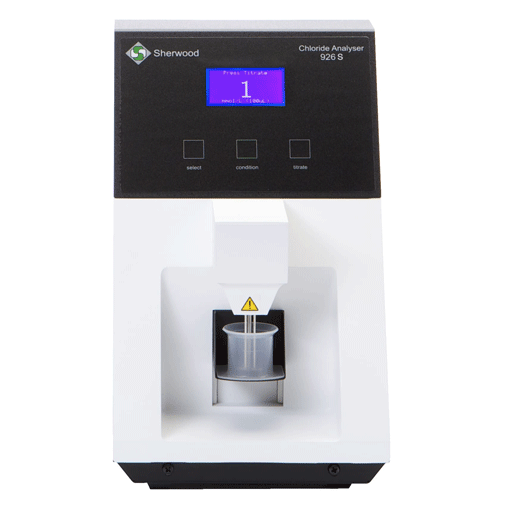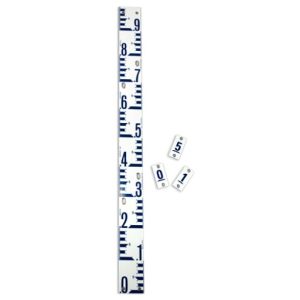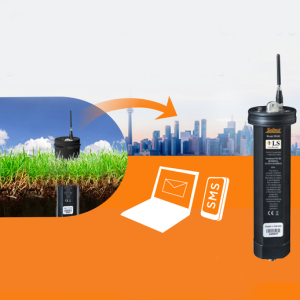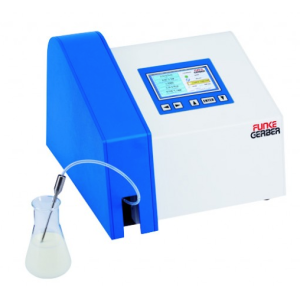Model 926 is used for the determination of chloride ions. It is an instrumental analog of “Argentimetry”, the traditional titrimetric methods using silver nitrate reagent.
Like these classic methods, it relies on the chemical formation of the very insoluble salt, silver chloride. The importance of chloride determination has been realized for well over a century, with many variations and changes being made to the techniques in order to improve the detectability and selectivity. Research into the analysis of chloride was conducted by Gay-Lussac (1832),Level (1853),Mohr (1856) and Volhard(1874) and their findings have proven to be the basis of the methods which are still in common use today.
The measurement of Salt (Sodium Chloride) concentration in the Food and Dairy Industry is universal. The ability to read direct in Salt concentration makes the model 926 the instrument of choice for manufacturers and food analysts around the world. Salt and salinity also represents serious contamination in Industrial processes and the sensitivity of the coulometric method enables measurement in the ppm range in boiler feed water, polymer washes. bore hole slurries, as well as soils analysis and others. The 926 has proven itself to be the method of choice for many desalination studies and general quality control of sample lines. Clinical measurement of the chloride ion is essential for monitoring of electrolyte balance of patients as it plays, in combination with sodium and potassium, an important part in maintaining water balance between cells, plasma and interstitial fluid. The Model 926s is also widely used in the confirmation of the diagnosis of Cystic Fibrosis. The model 926S variant can accept 20 microlitre samples. Sherwood Scientific has method notes for these and other Applications. Pharmaceutical Production, Cement Manufacture, Photography Veterinary.
The main difficulties with the classic method were that silver nitrate reagent would change on storage due to a photochemical reaction and that the titration end point is visually weak. The reagent would have to be standardized requiring a highly skilled analytical technician . The 926 method is based on a coulometric titration and is an absolute method where the reagent, the silver ions, is precisely and quantitatively generated at the time of the analysis by passing a constant current between donor electrodes. The end point is detected by the use of sensing electrodes which measure the change in solution conductivity which occurs when excess silver ions are present in solution.
The Buffer system is optimised to eliminate interfering ions and incorporates a special dispersant to ensure reproducible formation of the silver chloride precipitate and enhance analytical performance.
| Applications | |
| Agriculture | |
|
|
| Baking | |
|
|
| Brewing and Wine Production | |
|
|
| Cement manufacture* | |
|
|
| Dried Egg manufacture | |
|
|
| Meat and Fish Processing | |
|
|
| Protroleum and oil Production | |
|
|
| Pharmaceuticals | |
|
|
| Photography | |
|
|
| Food Manufacture | |
|
|
| Sample size | ||
| Specifications | ||
| Model 926 | Model 926S | |
| Sample size | 500 microlitres | 20 microlitres |
| Readout Range | 10-999mg Cl/l; 2-165mg%Salt | 10-299mmolCl/l |
| Analysis Time | 35 sec @ 200mgl/l | 35 sec@ 100mmolCl/l |
| Accuracy | SD <1% @ 0.1% Cl Std Solution | #ERROR! |
| Linearity | 1% in range 10-999mgCl/l | 1% 10-299 mmolCl/l |
| Reproducibility CV for 20 replicates | <1.5% @ 200mgCl/l | <1.5% @ 100mmolCl/l |
Model 926 is used for the determination of chloride ions. It is an instrumental analog of “Argentimetry”, the traditional titrimetric methods using silver nitrate reagent.
Like these classic methods, it relies on the chemical formation of the very insoluble salt, silver chloride. The importance of chloride determination has been realized for well over a century, with many variations and changes being made to the techniques in order to improve the detectability and selectivity. Research into the analysis of chloride was conducted by Gay-Lussac (1832),Level (1853),Mohr (1856) and Volhard(1874) and their findings have proven to be the basis of the methods which are still in common use today.
The measurement of Salt (Sodium Chloride) concentration in the Food and Dairy Industry is universal. The ability to read direct in Salt concentration makes the model 926 the instrument of choice for manufacturers and food analysts around the world. Salt and salinity also represents serious contamination in Industrial processes and the sensitivity of the coulometric method enables measurement in the ppm range in boiler feed water, polymer washes. bore hole slurries, as well as soils analysis and others. The 926 has proven itself to be the method of choice for many desalination studies and general quality control of sample lines. Clinical measurement of the chloride ion is essential for monitoring of electrolyte balance of patients as it plays, in combination with sodium and potassium, an important part in maintaining water balance between cells, plasma and interstitial fluid. The Model 926s is also widely used in the confirmation of the diagnosis of Cystic Fibrosis. The model 926S variant can accept 20 microlitre samples. Sherwood Scientific has method notes for these and other Applications. Pharmaceutical Production, Cement Manufacture, Photography Veterinary.
The main difficulties with the classic method were that silver nitrate reagent would change on storage due to a photochemical reaction and that the titration end point is visually weak. The reagent would have to be standardized requiring a highly skilled analytical technician . The 926 method is based on a coulometric titration and is an absolute method where the reagent, the silver ions, is precisely and quantitatively generated at the time of the analysis by passing a constant current between donor electrodes. The end point is detected by the use of sensing electrodes which measure the change in solution conductivity which occurs when excess silver ions are present in solution.
The Buffer system is optimised to eliminate interfering ions and incorporates a special dispersant to ensure reproducible formation of the silver chloride precipitate and enhance analytical performance.
| Applications | |
| Agriculture | |
|
|
| Baking | |
|
|
| Brewing and Wine Production | |
|
|
| Cement manufacture* | |
|
|
| Dried Egg manufacture | |
|
|
| Meat and Fish Processing | |
|
|
| Protroleum and oil Production | |
|
|
| Pharmaceuticals | |
|
|
| Photography | |
|
|
| Food Manufacture | |
|
|
| Sample size | ||
| Specifications | ||
| Model 926 | Model 926S | |
| Sample size | 500 microlitres | 20 microlitres |
| Readout Range | 10-999mg Cl/l; 2-165mg%Salt | 10-299mmolCl/l |
| Analysis Time | 35 sec @ 200mgl/l | 35 sec@ 100mmolCl/l |
| Accuracy | SD <1% @ 0.1% Cl Std Solution | #ERROR! |
| Linearity | 1% in range 10-999mgCl/l | 1% 10-299 mmolCl/l |
| Reproducibility CV for 20 replicates | <1.5% @ 200mgCl/l | <1.5% @ 100mmolCl/l |













